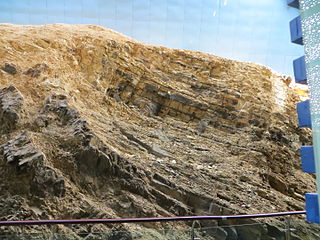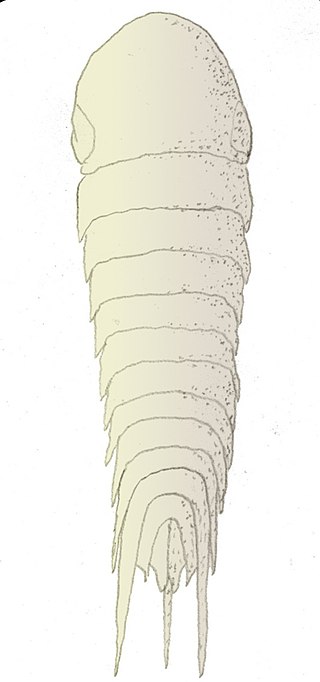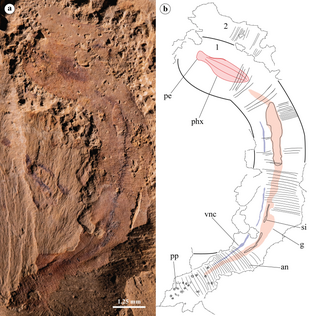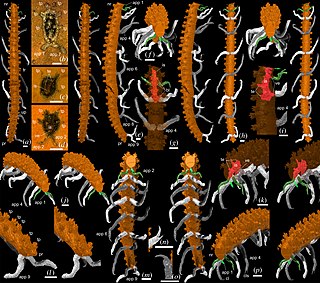Related Research Articles

The Maotianshan Shales are a series of Early Cambrian sedimentary deposits in the Chiungchussu Formation, famous for their Konservat Lagerstätten, deposits known for the exceptional preservation of fossilized organisms or traces. The Maotianshan Shales form one of some forty Cambrian fossil locations worldwide exhibiting exquisite preservation of rarely preserved, non-mineralized soft tissue, comparable to the fossils of the Burgess Shale of British Columbia, Canada. They take their name from Maotianshan Hill in Chengjiang County, Yunnan Province, China.

Parapeytoia is a genus of extinct arthropod that lived over 530 million years ago in the Maotianshan shales of prehistoric China. It was interpreted as an anomalocaridid (radiodont) with legs, but later studies reveal it was a megacheiran, a group of arthropods which are no longer thought to be closely related to the radiodonts.

Acanthomeridion is an extinct arthropod found in the Chengjiang fauna deposits of China. In 1997, it was placed in its own, monotypic family, Acanthomeridiidae. It is known from eight specimens, all found in China.

Haikoucaris is a genus of megacheiran arthropod that contains the single species Haikoucaris ercaiensis. It was discovered in the Cambrian Chengjiang biota of China.

Kunmingella is genus of Cambrian bradoriid from the Chengjiang biota, containing the single species K. douvillei. Kunmingella had 12 appendages, including a pair of antennae as well pairs of biramous limbs, including four anterior pairs of appendages bearing double rows of endites on their endopods, and a posterior 5 with only a single row of endites, as well as two terminal pairs of uniramous limbs. Eggs have been found preserved attached to the posteriormost three pairs of biramous limbs, suggesting it engaged in brood care. Around 50–80 eggs, each around 150–180 μm across were attached in total.
Kunyangella is genus of Cambrian arthropod known for being a member of the Chengjiang biota, containing the single species K. cheni. It has a bivalved carapace and has tentatively been referred to the Bradoriida.

Occacaris oviformis is an extinct nektonic predatory arthropod from the Lower Cambrian Maotianshan shale Lagerstätte. It bears a superficial resemblance to the Cambrian arthropod, Canadaspis, though, was much smaller, and had a pair of "great appendages", with which it may have grasped prey. It was originally considered to belong to Megacheira, however it is questioned in later study.

The palaeoscolecids are a group of extinct ecdysozoan worms resembling armoured priapulids. They are known from the Lower Cambrian to the late Silurian; they are mainly found as disarticulated sclerites, but are also preserved in many of the Cambrian lagerstätten. They take their name from the typifying genus Palaeoscolex. Other genera include Cricocosmia from the Lower Cambrian Chengjiang biota. Their taxonomic affinities within Ecdysozoa have been the subject of debate.

Vetulicola cuneata is a species of extinct animal from the Early Cambrian Chengjiang biota of China. It was described by Hou Xian-guang in 1987 from the Lower Cambrian Chiungchussu Formation, and became the first animal under an eponymous phylum Vetulicolia.

Cucumericrus decoratus is a species of putative radiodont known from a few poorly preserved specimens. Only fragments of trunk cuticle and corresponded appendages had been revealed, while important radiodont features such as frontal appendages are unknown in this species. The trunk cuticle possess irregular wrinkles and may had been soft in life. Each of the trunk appendage compose of a dorsal flap-like element and a ventral stubby leg with unknown distal region, structurally comparable to the trunk appendages of gill lobopodians and euarthropod biramous appendages. The legs have been interpreted as somewhere between annulated lobopod legs and segmented arthropod legs.

Maotianshania cylindrica is an extinct worm-like creature of average size. It occurs in the Lower Cambrian (Atdabanian) Chengjiang biota of Northeastern Yunnan, China. It is usually preserved as pink impression. The gut is a dark central zone. The anterior pharnyx and "collar", carry tiny sepia-colored teeth. The very back-end of the body has two small hooks.
Archotuba is a genus of elongated conical tubes that were seemingly deposited by colonial organisms. Known from the Chengjiang, its biological affinity is uncertain; it somewhat resembles the tubes of the 'priapulid' Selkirkia, but a cnidarian affinity is also possible. In the absence of soft parts, there really isn't enough data to confirm a biological affiliation.

Acosmia is a genus of Chengjiang biota priapulid in the family Acosmiidae. It is represented by a single rare species, Acosmia maotiania. Later studies proposed it is a stem-group ecdysozoan.
Nidelric is a Cambrian genus of scleritomous organism, tentatively interpreted as a chancelloriid.

Luohuilinella is an extinct genus of xandarellid artiopodan arthropod known from the Chengjiang biota of China. The type species Luohuilinella rarus was described in 2012. A second species Luohuilinella deletres was described in 2018. Both taxa are rare components of the assemblage. Like other Xandarellids and most artiopodans, it possessed an unmineralised exoskeleton. The type and currently only known specimen of L. rarus is known from a dorsal exoskeleton, around 17 mm long and 9 mm wide which consists of 27 tergites with pronounced pleural spines. L. deletres is much larger, with specimens being over 10 cm long, L. deletres possessed at least 11 pairs of biramous appendages. Both taxa are dorsoventrally flattened, making a benthic or nektobenthic lifestyle probable. Both taxa have pronounced notches in the cephalon to accommodate the stalked eyes.
Luolishania is an extinct genus of lobopodian panarthropod and known from the Lower Cambrian Chiungchussu Formation of the Chengjiang County, Yunnan Province, China. A monotypic genus, it contains one species Luolishania longicruris. It was discovered and described by Hou Xian-Guang and Chen Jun-Yuan in 1989. It is one of the superarmoured Cambrian lobopodians suspected to be either an intermediate form in the origin of velvet worms (Onychophora) or basal to at least Tardigrada and Arthropoda. It is the basis of the family name Luolishaniidae, which also include other related lobopods such as Acinocricus, Collinsium, Facivermis, and Ovatiovermis. Along with Microdictyon, it is the first lobopodian fossil discovered from China.

Thanahita is a genus of extinct lobopodian and known from the middle Silurian Herefordshire Lagerstätte at the England–Wales border in UK. It is monotypic and contains one species, Thanahita distos. Discovered in 2018, it is estimated to have lived around 430 million years ago and is the only known extinct lobopodian in Europe, and the first Silurian lobopodian known worldwide.

Hallucigeniidae is a family of extinct worms belonging to the group Lobopodia that originated during the Cambrian explosion. It is based on the species Hallucigenia sparsa, the fossil of which was discovered by Charles Doolittle Walcott in 1911 from the Burgess Shale of British Columbia. The name Hallucigenia was created by Simon Conway Morris in 1977, from which the family was erected after discoveries of other hallucigeniid worms from other parts of the world. Classification of these lobopods and their retatives are still controversial, and the family consists of at least four genera.

Lenisambulatrix is a genus of extinct worm belonging to the group Lobopodia and known from the Lower Cambrian Maotianshan shale of China. It is represented by a single species L. humboldti. The incomplete fossil was discovered and described by Qiang Ou and Georg Mayer in 2018. Due to its missing parts, its relationship with other lobopodians is not clear. It shares many structural features with another Cambrian lobopodian Diania cactiformis, a fossil of which was found alongside it.
Hou Xian-guang is a Chinese paleontologist at Yunnan University who made key discoveries in the Cambrian life of China around 518 myr. His first discovery of animal fossils from the Cambrian sediments at Chengjiang County, Yunnan Province, led to the establishment of the Chengjiang biota, an assemblage of various life forms during the Cambrian Period. The discovery of the Chengjiang biota, remarked as "among the most spectacular in this [20th] century", added to the better understanding of how animal forms originated and evolved during the so-called Cambrian explosion.
References
- 1 2 3 4 Hou, Xianguang; Bergström, Jan (2003-03-31). "The Chengjiang fauna — the oldest preserved animal community". Paleontological Research. 7 (1): 55–70. doi: 10.2517/prpsj.7.55 . ISSN 1342-8144. S2CID 129110862.
- 1 2 Hou, Xian‐guang; Siveter, David J.; Siveter, Derek J.; Aldridge, Richard J.; Cong, Pei‐yun; Gabbott, Sarah E.; Ma, Xiao‐ya; Purnell, Mark A.; Williams, Mark (2017-03-11). "Algae". The Cambrian Fossils of Chengjiang, China: The Flowering of Early Animal Life (2nd ed.). John Wiley & Sons, Ltd. pp. 39–47. doi:10.1002/9781118896372.ch8. ISBN 978-1-118-89637-2.